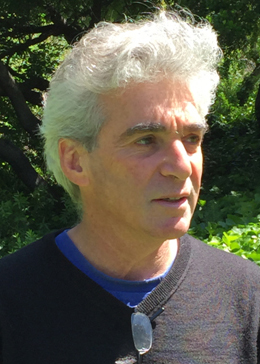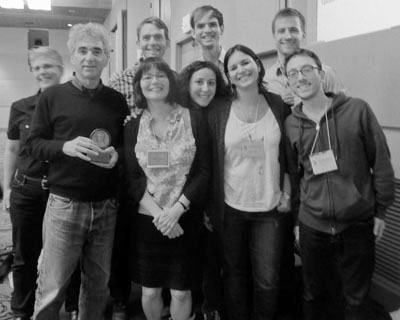Michael Levine Awarded 2015
Conklin Medal
By Marsha E. Lucas
 The 2015 Society for Developmental Biology
Edwin G.
Conklin Medal was awarded to
Michael Levine of Princeton University for his
extraordinary research contributions to the field of
developmental biology and training of the next
generation of scientists. Levine’s extensive work
uncovering transcriptional mechanisms in developing
fly and sea squirt embryos has enhanced our
understanding of gene regulation and evolution. As a
postdoc with
Walter Gehring, he and
William McGinnis discovered the homeobox protein
domain. Later, as an independent investigator,
Levine’s group systematically dissected the
even-skipped (eve) stripe 2 enhancer to
show how discreet stripes of expression depend on
the integration of broadly expressed transcriptional
activators and locally expressed repressors. In
addition to work on Dorsal morphogen gradient
thresholds and shadow enhancers, his group has taken
up evo-devo studies in Ciona in an effort to
understand vertebrate innovations like the neural
crest and cranial placodes. The 2015 Society for Developmental Biology
Edwin G.
Conklin Medal was awarded to
Michael Levine of Princeton University for his
extraordinary research contributions to the field of
developmental biology and training of the next
generation of scientists. Levine’s extensive work
uncovering transcriptional mechanisms in developing
fly and sea squirt embryos has enhanced our
understanding of gene regulation and evolution. As a
postdoc with
Walter Gehring, he and
William McGinnis discovered the homeobox protein
domain. Later, as an independent investigator,
Levine’s group systematically dissected the
even-skipped (eve) stripe 2 enhancer to
show how discreet stripes of expression depend on
the integration of broadly expressed transcriptional
activators and locally expressed repressors. In
addition to work on Dorsal morphogen gradient
thresholds and shadow enhancers, his group has taken
up evo-devo studies in Ciona in an effort to
understand vertebrate innovations like the neural
crest and cranial placodes.
Levine’s interest in development was piqued as an
undergraduate student in
Fred Wilt’s developmental biology class at the
University of California, Berkeley. In an interview
last Spring, Levine said the sea urchin molecular
biologist was an “absolutely inspired teacher.”
Wilt’s “raw enthusiasm” and willingness to teach not
only what was known in 1975, but also discuss the
future frontiers, convinced Levine that the field of
developmental biology was poised for tremendous
discovery. “He just completely defined what I wanted
to do,” Levine said.
After Berkeley, Levine headed to Yale University for
graduate school where he joined the lab of bacterial
geneticist,
Alan Garen. Garen, famous for identifying some
of the first stop codons in bacteria in the 1960s,
switched to Drosophila in the early 1970s.
“The lab was pretty small,” Levine said. “So, I had
a lot of individual attention from him. Sometimes
more than I wanted.”
As an advisor Garen was quite critical, so Levine
had to bring his A game when discussing his research
with him. "It was kind of a tough experience because
he was really hard core and old school, but I look
back and realize that that was extremely rigorous
training. It was just intellectually rigorous."
Levine’s graduate work on genome modifications in
developmentally regulated Drosophila genes,
along with a friendly call from his advisor to the
biology chair at Columbia University (Cyrus
Levinthal), earned him a faculty job offer
before he even graduated from Yale.
Fortunately, they suggested he do a postdoc before
coming to Columbia, otherwise, he might have missed
out on one of the most fruitful collaborations of
his career. Levine went to the University of Basel
to do a postdoc with Walter Gehring. There he met
two of his closest scientific colleagues—Bill
McGinniss and
Ernst Hafen—and together they discovered the
homeobox protein domain found in homeotic genes
which control the fly body plan. “It was just really
fun working with those guys,” Levine said. “I didn’t
realize at the time but that was probably the single
most exciting period I would have in science.”
After a short postdoc at UC Berkeley with
Gerry Rubin, Levine joined the faculty at
Columbia in 1984. In 1991, he moved to the UC, San
Diego and six years later he became a professor at
his alma mater, UC Berkeley.
As Levine moved up the ranks of academia, he credits
the informal mentorship of fellow fly guy,
Peter Lawrence,
with making him a better science communicator.
“Peter is a guy who really values the scientific
community and has always reached out to younger
people,” Levine said.
“Peter heard me give talks and he said, ‘This is
really important stuff but you’re not communicating
it very well.’” He helped Levine write better papers
and give better talks.
“I look back at that and I just think, Wow, who
ever does that? It was rare then. And it’s
nonexistent now. And I’m just really grateful to him
for that.”
At Berkeley, Levine was widely regarded as one of
the best teachers in the Molecular and Cell Biology
Department, something he worked hard at because he
had such great teachers as a student there.
As for his personal mentoring style, Levine admits,
“I’m not always the calmest, most rational mentor
with the students and postdocs in my lab.”
He has extremely high expectations and would prefer
they eat and breathe their science. The best ideas,
he said, often come when you least expect it—like in
the shower or taking a walk. Those are not times to
be planning what movie to see, but rather, what your
next experiment should be.
|
 |
|
Levine with current and former trainees
after receiving Conklin Medal at SDB
74th Annual Meeting in Snowbird, Utah. |
“I guess that’s a little hard core. But that’s
my—that’s kind of my deal [laughter],” he said.
Many of Levine’s former trainees have gone on to
exceptional careers of their own. The most rewarding
part of his job is when a student or postdoc
surprises him with some interesting result.
About a year ago his graduate student, Jacques
Bothma, and rotation student, Gavin Schlissel,
knocked on his office door to show him a movie they
made of
eve stripe 2 expression in living
Drosophila embryos. From one to three hours
after fertilization you see individual nascent RNAs
produced from the eve stripe 2 enhancer. Expression
is initially broad; then a stripe forms; and then it
quickly disappears.
“For me that was almost a religious experience. It
was so beautiful,” he said. “After doing in situ
hybridizations for 30 years and always trying to
imagine what it would look like if we could ever do
this in a living embryo. I can tell you the whole
thing was much faster than I ever was able to replay
in my head.”
This summer after 19 years at the University of
California, Berkeley, Levine became the new director
of the Lewis-Sigler Institute for Integrative
Genomics at Princeton University.
Winning the Conklin Medal was particularly special
for him because Conklin, a sea squirt developmental
biologist, is one of his science heroes. “Conklin
taught us the importance of lineages in producing
complex tissues, organs, and structures,” he said.
“My overarching research has really been focused on
transcription mechanisms in the fly embryo. But, I
just can’t shake my love of that sea squirt embryo.
I mean, I really like it. It’s in a sweet spot on
the evolutionary tree of life...it’s freaking
outstanding.”
His lab is now split about 50:50 between
Drosophila and Ciona research. He would like
scientists today to remember Conklin’s contributions
from the classical era of developmental biology.
“We haven’t done Conklin as proud as the frog guys
have done [Hans] Spemann. But, eh, maybe we’ll turn
the tide?”
|